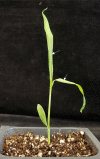Agrobacterium-mediated transient transformation of sorghum leaves for accelerating functional genomics and genome editing studies
- PMID: 32103777
- PMCID: PMC7045639
- DOI: 10.1186/s13104-020-04968-9
Agrobacterium-mediated transient transformation of sorghum leaves for accelerating functional genomics and genome editing studies
Abstract
Objectives: Sorghum is one of the most recalcitrant species for transformation. Considering the time and effort required for stable transformation in sorghum, establishing a transient system to screen the efficiency and full functionality of vector constructs is highly desirable.
Results: Here, we report an Agrobacterium-mediated transient transformation assay with intact sorghum leaves using green fluorescent protein as marker. It also provides a good monocot alternative to tobacco and protoplast assays with a direct, native and more reliable system for testing single guide RNA (sgRNA) expression construct efficiency. Given the simplicity and ease of transformation, high reproducibility, and ability to test large constructs, this method can be widely adopted to speed up functional genomic and genome editing studies.
Keywords: Agrobacterium; CRISPR; Sorghum; Transformation; Transient; sgRNA.
Conflict of interest statement
The authors declare that they have no competing interests.
Figures




